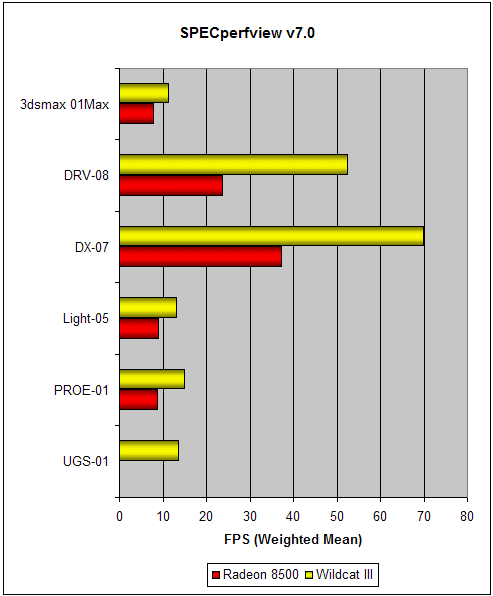Performance
Being a workstation board Wildcat III has a different design brief in mind when it comes to the applications it will run in comparison to our usual desktop PC gaming boards. Wildcat III only has a trilinear filtered 400M pixels per second peak theoretical fill rate, which isn’t a great deal when compared to a current gaming board such as ATi's Radeon 8500 or nVIDIA's GeForce 4 Ti series, and as would not expect terribly good games performance with this pixel fill rate.
For such a large and expensive board a 400Mpps fill rate may seem small, however, this is where one of the major areas of design differences between the two boards come in – Radeon 8500 was designed to run (relatively) uncomplicated scenes as quickly as possible, whereas Wildcat III was designed to run very complicated scenes acceptably, hence large quantities of its die space are dedicated to other things (as the 6 T&L and 4 triangle setup engines indicate). Workstation boards are geared towards making scenes as realistic as possible, and quite often this is achieved through geometric complexity; gaming 3D cards on the other hand are designed to make good looking games run as fast as possible, however currently games rarely need to be truly realistic. In essence something such as a game shows the completely worst case scenario for a board such as the Wildcat since it was not designed to run games at all and anyone shopping around for a board such as this will likely not have gaming performance high on their list of priorities at all.
Now, lets have a look to see how a current gaming board, in this instance the Radeon 8500 stacks up against the Wildcat III in the cat's natural habitat. for this test we’ll use the relatively newly released SPECviewperf 7.0 benchmark.
The SPECviewperf benchmark comprises of a suite of benchmarks that are designed to measure the performance of a board representing popular CAD/CAM/CAE and digital content creation (DCC) applications. All the SPECviewperf tests run under OpenGL. More information on what SPECviewperf is can be found here and the release highlighting what’s new in SPECviewperf 7.0 can be found here.

Here we can see the opposite situation to the game benchmarks, in all cases the Wildcat III outperforms Radeon 8500, and in many cases significantly so. In the case of the Unigraphics (UGS-01) benchmark the Radeon 8500 didn't actually fail, however it took in excess of 7 hours to render one of the scene's -- I stopped it after that point figuring it probably wouldn't have a very high FPS anyway!
Anyway, this benchmark clearly illustrates that Wildcat III is far better suited to the types of applications the SPECperfview tests, it also shows that most of these tests are not reliant on Pixel fill rate as much as other elements of the rendering process, most likely geometry processing in many cases.
| System Setup |
|
2GHz
Intel Pentium 4 'Northwood' CPU 3Dlabs Wildcat III -- v06.05.03.15 Driver |
